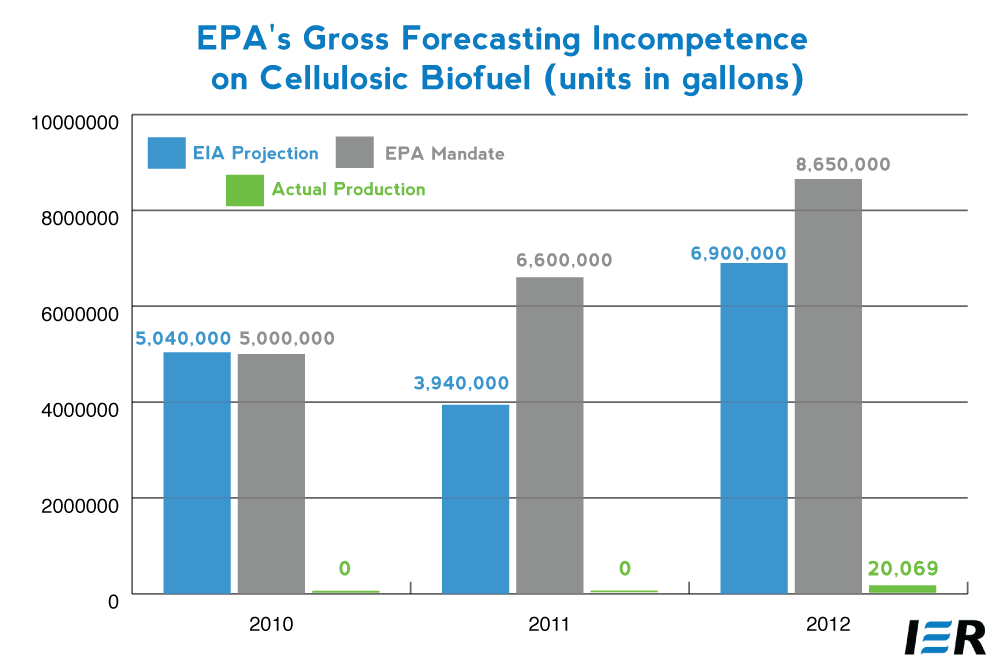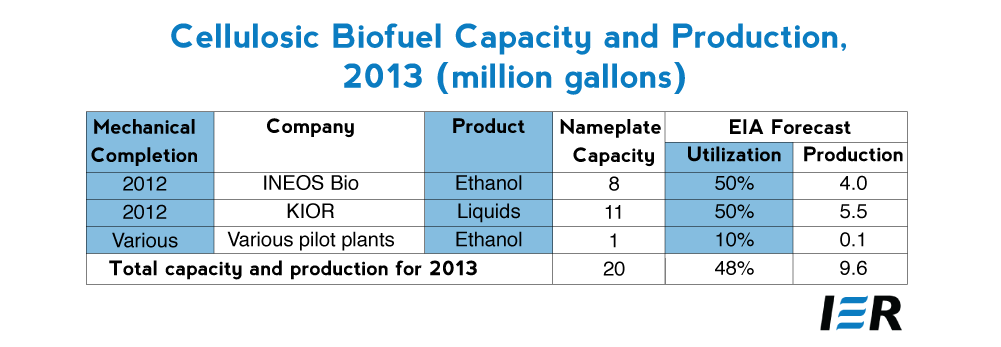The U.S. Environmental Protection Agency (EPA) is dictating that refiners must purchase a certain amount of cellulosic biofuels or pay penalties. EPA grossly over-forecast the amount of cellulosic ethanol for the past three years and will almost certainly ignore its past mistakes and once against require millions of gallons of non-existent fuel again this year. They have taken this position despite a National Research Council study that said oil prices would have to reach $191 per barrel in order for biofuels to be competitive with petroleum.
The problem is that EPA cannot forecast the amount of cellulosic ethanol correctly—or even closely. Further, EPA is likely to order an increased amount be purchased regardless of past failures – King Canute-like — in the hope that their mandated levels will mysteriously appear in the U.S. market
Lest anyone only blame EPA for gross forecasting incompetence, a Democratic Congress led by Speaker Nancy Pelosi and Senate Majority Leader Harry Reid joined forces with Republican President George W. Bush to give EPA the authority to do this in the Energy Independence and Security Act of 2007 that mandated specific levels of biofuels be produced, both from corn and from cellulosic materials such as corn husks and other crop waste, wood chips, switch grass, poplar, and other energy crops.
Through the first 10 months of 2012, EPA reports that 20,069 gallons of cellulosic ethanol were produced[i]. The problem, however, is that EPA forecast 431 times that amount (8.65 million gallons) would be produced. Further, all of the 20,069 gallons was exported.[ii] While EPA has not yet released its 2013 mandated level, the Energy Information Administration (EIA) has provided its input to EPA, suggesting that 9.6 million gallons will be produced in 2013. EIA provides its forecast to EPA each October, as required, and it has always been a lower amount than EPA’s mandate. However, neither agency has yet been able to predict the amount correctly. In fact, the closest EPA has even come to correctly forecasting the amount of cellulosic ethanol produced was in 2010 when zero cellulosic ethanol was produced and EPA estimated that 5 million gallons would be produced.
The following chart shows EIA projection for cellulosic fuels, along with EPA’s mandate, and actual production:
The Cellulosic Biofuels Requirement
It’s easy to blame EPA because their forecasts have been terribly flawed and they continue to estimate wildly unrealistic amounts of cellulosic production. But the reason that EPA has this power is because of the Energy Independence and Security Act of 2007. That act mandated the production of cellulosic fuel to reach 100 million gallons in 2010, 250 million gallons in 2011, 500 million gallons in 2012, and 1 billion gallons in 2013.[iii] EPA lowered those figures to 6.6 million gallons for 2011 and 8.65 million gallons for 2012, just a small fraction of the original numbers (about 2 percent), but an incredibly large amount when cellulosic biofuels do not exist commercially at anywhere near even those levels. EIA provided lower amounts to EPA of 3.94 million gallons in 2011 and 6.9million gallons in 2012.[iv] But none was produced commercially in 2011, and only 20,069 gallons through October 2012 were produced and exported. EIA’s estimate for 2013 is 9.6 million gallons. (See table below.)
Cellulosic Biofuel Capacity and Production, 2013 (million gallons)
Source: Energy Information Administration, http://www.eia.gov/biofuels/issuestrends/pdf/bit.pdf
Expectations for the Industry
Kior opened the first commercial cellulosic biofuel plant in the United States in October 2012 and is expected to break ground in 2013 on a second facility, which will be able to produce about 40 million gallons a year when at full capacity. Ineos Bio’s plant in Vero Beach, Florida has an annual production capacity of 8 million gallons. EIA expects Kior’s Mississippi plant and Ineos Bio’s Florida plant to run at 50 percent capacity this year.
Four companies (Kior and 3 others) expect to open refineries by the end of 2013 and two additional plants are scheduled to begin production the following year, but their production will be short of the mandated level of 1.75 billion gallons in 2014.[v] Plants expected to be open in 2013 include: Abengoa’s plant in Kansas with a capacity of 25 million gallons a year, which was helped with a $132 million government loan, Poet LLC’s plant in Iowa also with a capacity of 25 million gallons a year, and Fiberight LLC’s plant in Iowa with about 4 million gallons of capacity. In 2014, DuPont Co. is expected to open a plant with annual capacity of 30 million gallons using corn stover residues, a feedstock composed of corn stalks and leaves, and Chemtex International, a unit of an Italian chemical company, is expected to open a facility with 20 million gallons of capacity.[vi]
But all is not rosy. For example, the DuPont facility expected to be open in mid-2014 has been in development for 10 years. When this $200 million facility is completed, it will be among the first and largest commercial-scale cellulosic biorefineries in the world, but will require a capital investment of about $7 per gallon of annual capacity[vii], more than twice the current cost of gasoline.
In October 2012, BP cancelled a $350 million, 36-million-gallon-per-year plant in Highlands County, Florida even though BP had already started developing a 20,000-acre farm to grow special crops for the plant. The crop was a sugar cane that produces larger amounts of biomass and less sugar than the kind of sugar cane that Brazil uses to make ethanol.[viii]
Reasons to Still Be Cautious About the Industry
First, the market for ethanol is basically saturated with corn derived ethanol. According to EIA, corn-derived ethanol is supplying 9.6 percent of the 10 percent blend with gasoline that EPA originally mandated.[ix] While EPA raised the limit to 15 percent for cars and light trucks of model year 2001 and newer, gas stations are reluctant to switch to the 15 percent blend because about a third of their customers will not be able to use it. Also, concerns related to automobile warranties, potential liability for misfueling, and infrastructure costs are likely to limit its use, at least in the near term.
Second, cellulosic technology is not likely to be competitive. The actual costs of production on a commercial scale are not generally known because current costs are based on small-scale pilot plants and the chemistry of how the enzymes and microorganisms used in the process will perform at a large commercial scale have not been determined. For example, the cost for the BP plant cancelled in Florida is estimated to be as much as 10 times higher than for a corn-based ethanol plant for the first plants constructed.
Field studies have been done recently to determine how much the feedstocks (the grasses, wood chips, straw, or corn stover) cost to grow, harvest, and get to a biofuels plant. Recent estimates place the cost at $80 to $130 a ton, compared to earlier estimates that suggested around $30 a ton. That means the fuel input required to make a gallon of cellulosic ethanol from these materials will cost $1.30 to $1.48 before they are even processed into ethanol. Compare that to corn-based ethanol that costs around $2.40 a gallon, and the competitiveness of cellulosic ethanol is hard to find.[x]
Conclusion
The future of cellulosic biofuels is still uncertain, as demonstrated by EIA’s forecast for 2013 production at less than 1 percent of the legislated mandate. While past history has shown EIA’s projected levels to be too high, EPA has regularly raised them when determining the revised mandate. And, unfortunately, once the data are in, the agency still refuses to revise the estimate, causing refiners to pay large fines for a non-existent fuel and increasing the cost of gasoline to consumers.[xi]
Here again we see the direction of the Obama Administration in picking energy losers, for in March 2011, President Obama indicated a desire to get four new cellulosic ethanol refineries up and running by 2013.[xii] Whether these plants would be economic didn’t matter, for his EPA would just mandate the use of the fuel regardless of cost.
[i] Environmental Protection Agency, data through November 7, 2012, http://www.epa.gov/otaq/fuels/rfsdata/2012emts.htm
[ii] Ethanol Producer Magazine, AFPM petitions EPA to waive 2012 cellulosic mandate, January 2, 2013, http://www.ethanolproducer.com/articles/9418/afpm-petitions-epa-to-waive-2012-cellulosic-mandate
[iii] New York Times, Food vs. Fuel in 2013, December 24, 2012, http://green.blogs.nytimes.com/2012/12/24/food-vs-fuel-in-2013/
[iv] Energy Information Administration, Biofuels Issues and Trends, October 2012, http://www.eia.gov/biofuels/issuestrends/pdf/bit.pdf
[v] Public Law 110-140, December 19, 2007, http://www.gpo.gov/fdsys/pkg/PLAW-110publ140/pdf/PLAW-110publ140.pdf
[vi] Bloomberg, Cellulosic Biofuel to Surge in 2013 as First Plants Open, December 11, 2012, http://www.bloomberg.com/news/2012-12-11/cellulosic-biofuel-to-surge-in-2013-as-first-plants-open.html
[vii] Environment News Service, DuPont Builds Giant Cellulosic Ethanol Biorefinery in Iowa, December 11, 2012, http://ens-newswire.com/2012/12/12/dupont-builds-giant-cellulosic-ethanol-biorefinery-in-iowa/
[viii] MIT Technology Review, BP Plant Cancellation Darkens Cellulosic Ethanol’s Future, November 2, 2012, http://www.technologyreview.com/news/506666/bp-plant-cancellation-darkens-cellulosic-ethanols-future/
[ix] Energy Information Administration, Biofuels Issues and Trends, October 23, 2012, http://www.eia.gov/biofuels/issuestrends/
[x] Ibid.
[xi] Ethanol Producer Magazine, AFPM petitions EPA to waive 2012 cellulosic mandate, January 2, 2013, http://www.ethanolproducer.com/articles/9418/afpm-petitions-epa-to-waive-2012-cellulosic-mandate
[xii] Auto Blog, EPA reduces its cellulosic mandate again for 2012, June 26, 2011, http://www.autoblog.com/2011/06/26/epa-reduces-its-cellulosic-ethanol-mandate-again-for-2012/





